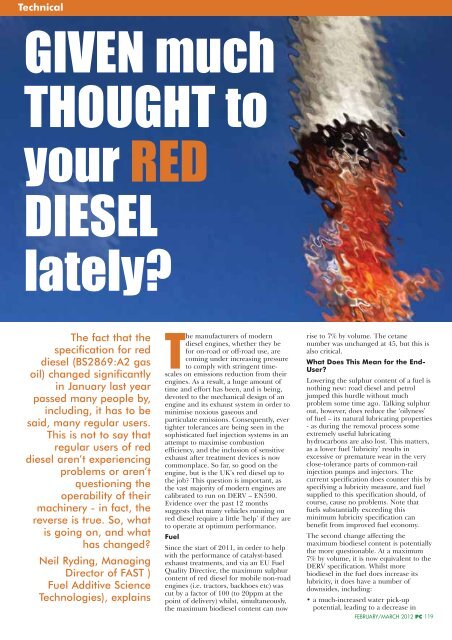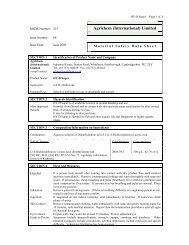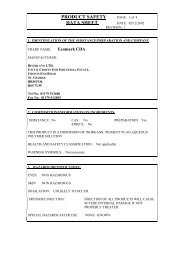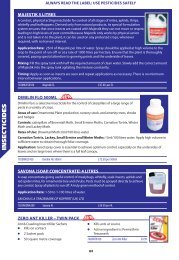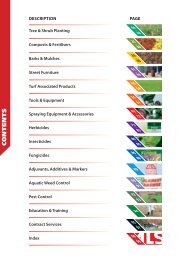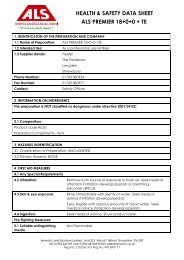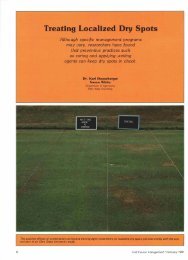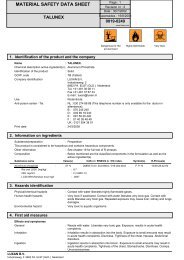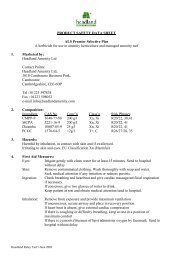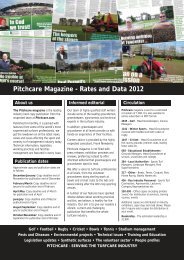these Open Championship Clubs choose to relief grind - Pitchcare
these Open Championship Clubs choose to relief grind - Pitchcare
these Open Championship Clubs choose to relief grind - Pitchcare
Create successful ePaper yourself
Turn your PDF publications into a flip-book with our unique Google optimized e-Paper software.
Technical<br />
GIVEN much<br />
THOUGHT <strong>to</strong><br />
your RED<br />
DIESEL<br />
lately?<br />
The fact that the<br />
specification for red<br />
diesel (BS2869:A2 gas<br />
oil) changed significantly<br />
in January last year<br />
passed many people by,<br />
including, it has <strong>to</strong> be<br />
said, many regular users.<br />
This is not <strong>to</strong> say that<br />
regular users of red<br />
diesel aren’t experiencing<br />
problems or aren’t<br />
questioning the<br />
operability of their<br />
machinery - in fact, the<br />
reverse is true. So, what<br />
is going on, and what<br />
has changed?<br />
Neil Ryding, Managing<br />
Direc<strong>to</strong>r of FAST )<br />
Fuel Additive Science<br />
Technologies), explains<br />
The manufacturers of modern<br />
diesel engines, whether they be<br />
for on-road or off-road use, are<br />
coming under increasing pressure<br />
<strong>to</strong> comply with stringent timescales<br />
on emissions reduction from their<br />
engines. As a result, a huge amount of<br />
time and effort has been, and is being,<br />
devoted <strong>to</strong> the mechanical design of an<br />
engine and its exhaust system in order <strong>to</strong><br />
minimise noxious gaseous and<br />
particulate emissions. Consequently, ever<br />
tighter <strong>to</strong>lerances are being seen in the<br />
sophisticated fuel injection systems in an<br />
attempt <strong>to</strong> maximise combustion<br />
efficiency, and the inclusion of sensitive<br />
exhaust after treatment devices is now<br />
commonplace. So far, so good on the<br />
engine, but is the UK’s red diesel up <strong>to</strong><br />
the job? This question is important, as<br />
the vast majority of modern engines are<br />
calibrated <strong>to</strong> run on DERV – EN590.<br />
Evidence over the past 12 months<br />
suggests that many vehicles running on<br />
red diesel require a little ’help’ if they are<br />
<strong>to</strong> operate at optimum performance.<br />
Fuel<br />
Since the start of 2011, in order <strong>to</strong> help<br />
with the performance of catalyst-based<br />
exhaust treatments, and via an EU Fuel<br />
Quality Directive, the maximum sulphur<br />
content of red diesel for mobile non-road<br />
engines (i.e. trac<strong>to</strong>rs, backhoes etc) was<br />
cut by a fac<strong>to</strong>r of 100 (<strong>to</strong> 20ppm at the<br />
point of delivery) whilst, simultaneously,<br />
the maximum biodiesel content can now<br />
rise <strong>to</strong> 7% by volume. The cetane<br />
number was unchanged at 45, but this is<br />
also critical.<br />
What Does This Mean for the End-<br />
User?<br />
Lowering the sulphur content of a fuel is<br />
nothing new: road diesel and petrol<br />
jumped this hurdle without much<br />
problem some time ago. Talking sulphur<br />
out, however, does reduce the ‘oilyness’<br />
of fuel – its natural lubricating properties<br />
- as during the removal process some<br />
extremely useful lubricating<br />
hydrocarbons are also lost. This matters,<br />
as a lower fuel ‘lubricity’ results in<br />
excessive or premature wear in the very<br />
close-<strong>to</strong>lerance parts of common-rail<br />
injection pumps and injec<strong>to</strong>rs. The<br />
current specification does counter this by<br />
specifying a lubricity measure, and fuel<br />
supplied <strong>to</strong> this specification should, of<br />
course, cause no problems. Note that<br />
fuels substantially exceeding this<br />
minimum lubricity specification can<br />
benefit from improved fuel economy.<br />
The second change affecting the<br />
maximum biodiesel content is potentially<br />
the more questionable. At a maximum<br />
7% by volume, it is now equivalent <strong>to</strong> the<br />
DERV specification. Whilst more<br />
biodiesel in the fuel does increase its<br />
lubricity, it does have a number of<br />
downsides, including:<br />
• a much-increased water pick-up<br />
potential, leading <strong>to</strong> a decrease in<br />
FEBRUARY/MARCH 2012 PC 119


